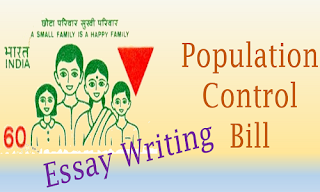Paragraph 1
Introduction
Recently, two Indian states – Uttar Pradesh and Assam, have advocated aggressive population control measures. With ongoing trends, India will overtake China as the most populous country by 2025 or perhaps sooner.
In 2001, India became the second country after China to cross the one billion mark. The current population is around 1.38 billion.
Therefore, the ‘Population Control Bill‘ (Population Regulation Bill) was introduced in Rajya Sabha in the year 2019. This bill is mainly introduced to promote the two-child policy, family planning, and control the expanding population day by day.
It also recommends incentives for government jobs, subsidies, and extra benefits under the public distribution system for those with two or fewer children. Other people will be denied these benefits.
Paragraph 2
Population Control Act 2016
This act came into force in the year 2016. According to this act, no person shall procreate more than two living children after a period of one year from the commencement of this act.
It came up with a two-child policy, famously known as “ham do humare do” which has been frequently used in public via advertisements.
The two-child policy is a government-imposed limit of two children allowed per family, with the perks of government subsidies given only to the first two children.
Therefore, the population bill is not new to Indians.
Paragraph 3
Necessity of the bill
To equally distribute basic needs like housing, foodstuffs, drinking water, quality education, job opportunities, etc. among the citizens from the available resources.
If there are more population and fewer resources, it is impossible to equally distribute resources among people.
We should also think about our future generations. If all the resources are distributed to us only, how will our future generation survive with insufficient resources?
As the population rises, so will poverty. This further increases other problems like illiteracy, unemployment, and inflation.
Therefore, to tackle all of these, there is a need for a population control bill/act so we can achieve the goal of sustainable development.
Paragraph 4
Advantages/contribution of the bill
There are many reasons, why this bill will help the country in sustainable development. The goal of sustainable development is to ensure healthy lives and promote well-being for all ages. If we do a small change in family planning/size, there will be a big change in the future population and we will be able to attain sustainable development.
Some changes we can see after implementing the population control bill:
- Changes in gender inequality
- Availability of clean water and sanitation
- Better implication of quality education
- Better health/medical services for all
- People will get justice in less time
- Unemployment will be reduced, and so will poverty.
Paragraph 5
Disadvantages of the bill
Still, many families in India want a male child. So, families can easily deny government benefits which will result in more sex-selective abortions like in China during the one-child policy.
Many women do not have a say in family matters. So, with this law, they may even lose control over their body because the male head of the family may control the women to avail of government benefits.
Most people with more than three children are poor. So, denying subsidies and benefits of government schemes will push them into more poverty.
Lack of awareness and availability of contraceptives result in more children. So, punishing the people with no awareness instead of educating them will be the mistake of the government.
Paragraph 6
Concerns/issues of the bill
A large population is not necessarily a bad thing for the economy. Population controlling measures will result in fewer people working for the economy which would lead the country to de-industrialization.
There would be poor demand for investment in places where companies encounter a falling population of consumers.
China enforced a one-child policy in the 1980s, but with an increasing share of older people in its population, China abandoned the old policy and encouraged couples to have more children now.
The bogey of population explosion is directly or indirectly used to target a particular minority in India. In this context, the bill will impact social harmony.
Paragraph 7
Possible solutions/way forward
According to the government’s population projections, 53.6% of India’s population in 2021 is under the age of 29. More than a quarter of India’s population is 14 years or younger. Our policymakers should focus on exploiting India’s demographic dividend rather than worrying about it.
India is still nowhere close to guaranteeing possible opportunities to young Indians. This young population can be extremely productive after upgrading the skill sets they require.
Education of women also plays a vital role in fertility rates. Hence, educating them will help in bringing down fertility and early birth among women.
Paragraph 8
Conclusion
India is at a stage of demographic transition where mortality rates are declining and fertility rates would decline in the next two to three decades or so. This leads to a scope to cut population growth because India still has a positive growth rate.
For the maintenance of production and consumption and the sake of future planning, it is necessary to implement a law on expanding population thus only problems like unemployment will be reduced and there will be a better scenario for jobless people.

Comments
Post a Comment
Need English Assistance, Have Doubts or Any Suggestions? Do let us know.